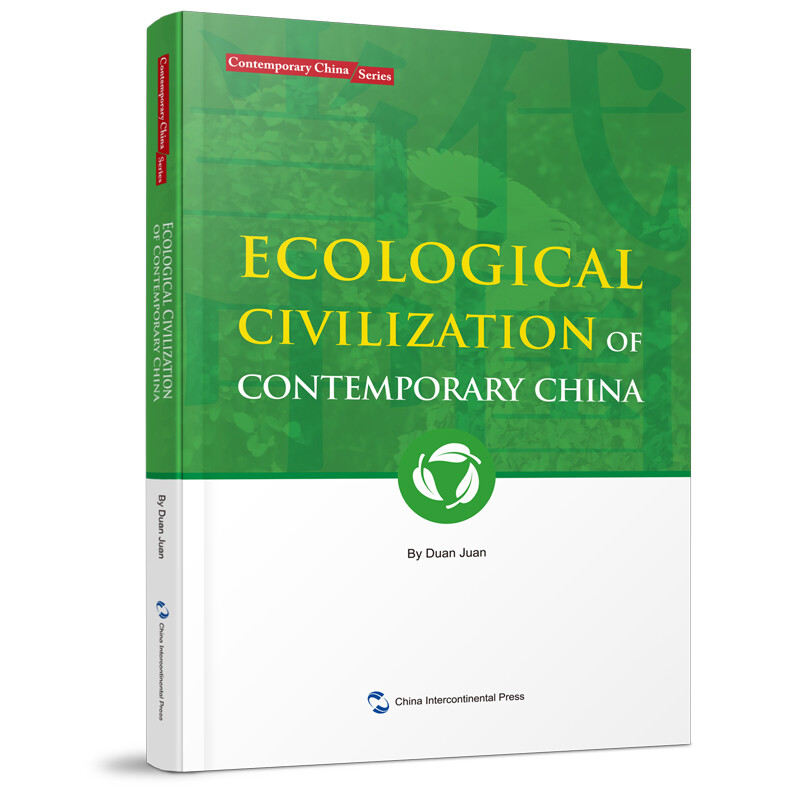
新版当代中国系列-当代中国生态文明(英)

温馨提示:5折以下图书主要为出版社尾货,大部分为全新(有塑封/无塑封),个别图书品相8-9成新、切口有划线标记、光盘等附件不全详细品相说明>>
- ISBN:9787508542409
- 装帧:一般胶版纸
- 册数:暂无
- 重量:暂无
- 开本:16开
- 页数:256
- 出版时间:2022-03-01
- 条形码:9787508542409 ; 978-7-5085-4240-9
本书特色
《当代中国生态文明》是全面、生动地介绍中国生态文明的知识性读物,图文并茂,有助于国内外读者更便捷、更清晰地了解中国特色生态文明建设道路。 This book comprehensively and vividly introduces China’s drive to build an ecological civilization. With thought-provoking text illustrated with photos, the book will help Chinese and foreign readers better understand the road to an ecological civilization with Chinese characteristics.
内容简介
建设生态文明,建设美丽中国,既是关系人民福祉、民族未来的长远大计,也是对当下严峻生态形势的积极应对,还是共建清洁美丽世界的重要组成部分。本书主要介绍中国生态文明建设的历程、生态文明新思想新理念,描述中国如何推动绿色低碳循环发展、推进生态修复和生态保护、参与优选生态环境治理等。
目录
Chapter I History, problems and challenges for ecological civilization
The start of environmental protection in the People’s Republic of China (1949–1978)
Environmental protection as a basic national policy and development of environmental protection (1978–1992)
Implementing the sustainable development strategy (1992–2002)
Constructing a resource-conserving and environmentally-friendly society (2002–2012)
Construction of an ecological civilization progressing to a new stage in the new era (2012 to now)
Problems and challenges for the construction of an ecological civilization
Chapter II New thoughts and new philosophy on ecological civilization
Upholding the principle of harmony between man and nature
Lucid waters and lush mountains are invaluable assets
A sound ecological environment is the most inclusive benefits to the people’s well-being
Mountains, rivers, forests, farmlands, lakes and grasslands are a shared community of life
Protecting the environment requires the best institutional arrangements and the strictest rule of law
Working together on global ecological conservation
Chapter III Promoting the development of green, low-carbon and circular economy
Adhering to the green, low-carbon path to development
Constructing a green, low-carbon industrial system
Utilization of clean coal and development of renewable energy
Promoting the development of circular economy
Construction of low-carbon cities and industrial parks
Green finance fuels development of green, low-carbon economy
Development of carbon capture, utilization and storage and the construction of carbon emissions trading markets
Chapter IV Fresh air, lucid waters, and clean lands
Building a beautiful China with blue skies, white clouds and fresh air
Building a beautiful China with lucid waters and green river banks
Building a beautiful China with less solid wastes and clean soil
Chapter V Promoting ecological restoration and protection
Implementing ecological restoration projects
Strengthening the construction of nature reserves and national parks
Promoting the red-line demarcation work for ecological protection
Strengthening the biodiversity protection
Chapter VI Taking part in global ecological and environmental governance
Participating and promoting the global climate governance
Promoting the construction of a green Belt and Road
Concluding remarks
节选
Green and low-carbon development stresses the conservation of resources and energy and circular utilization, the treatment and protection of environment and the reduction of greenhouse gas emissions in the course of development, in order to achieve the goal of overall economic and social sustainable development with the minimum consumption of energy and resources and the minimum damages to the ecological environment. Since the implementation of reform and opening-up policy in 1978, in the face of resources and environmental problems caused by the traditional extensive mode for development, and against the backdrop of vigorously coping with global climate change, the Chinese government has always upheld the resources conservation and environmental protection as the basic national policies, and incorporated the reduction in energy consumption intensity and carbon as the obligatory targets in the medium- and long-term plan for national economic and social development. For instance, the outline of the 13th Five-Year Plan (2016–2020) stated clearly some obligatory targets for energy saving, consumption reduction and reduction of greenhouse gas emissions, including “energy consumption per unit of GDP dropping by 15%, carbon dioxide emissions per unit of GDP declining by 18% and the ratio of non-fossil energy in the consumption of primary energy rising to 15% by 2020.”
作者简介
段娟,理学博士,中国社会科学院当代中国研究所副研究员,主要从事中华人民共和国区域经济史和生态环境史研究。已出版专著《中国区域经济发展研究》、个人论文集《中国区域发展与生态文明建设研究》,参编著作多部。在《中国软科学》《中国人口??资源与环境》《当代中国史研究》《教学与研究》等学术期刊上发表论文40余篇。 Duan Juan, doctor of science and associate research fellow with the Institute of Contemporary China Studies under the Chinese Academy of Social Sciences, specializes in the research of the history of China’s regional economy and the history of the ecological environment, and has published several books and monographs, including Research on China’s Regional Economic Development, and collection of papers Research on China’s Regional Development and Construction of Ecological Civilization. Duan has also taken part in compiling several books, and published more than 40 papers in academic periodicals and journals such as China Soft Science, China Population, Resources and Environment, China Contemporary History Studies, and Teaching and Research.
-

黑科技驱动世界的100项技术
¥20.9¥69.8 -

铁道之旅:19世纪空间与时间的工业化
¥20.7¥59.0 -

二战信息图 数据化全景透视第二次世界大战
¥163.5¥268.0 -

船舶综合驾驶台通信与导航系统:::
¥41.8¥58.0 -

博识百科系列--汽车摩托车大百科
¥103.5¥138.0 -

西门子S7-1200 PLC项目化教程
¥39.4¥54.0 -

选矿手册。第1卷
¥14.3¥42.0 -

欧亚草原古代治金
¥70.6¥98.0 -

国家电网有限公司安全生产事故事件分析报告汇编(2010-2021年)
¥126.4¥160.0 -

工业聚乙烯导论
¥73.5¥98.0 -

煤矿工人情景意识的fnlrs脑功能连接特征与分类识别研究
¥49.3¥88.0 -

公路隧道工程施工安全风险评估方法及典型案例分析
¥49.5¥90.0 -

(教材)产业用纺织品实验教程
¥38.3¥58.0 -

全球稀有金属流动格局演变与我国供应安全研究
¥59.0¥82.0 -

中国船闸文明演变进化史研究
¥49.0¥68.0 -

多媒体多模态融合的情感分析网络
¥17.4¥29.0 -

从模仿到创新:苏联液体弹道火箭技术的发展1944-1951
¥55.4¥88.0 -

水污染治理技术
¥29.0¥46.0 -

熔喷非织造成形理论
¥65.3¥99.0 -

生态文明教育理论与实践探索
¥48.4¥88.0








